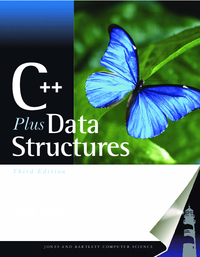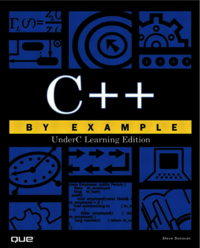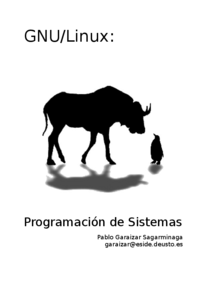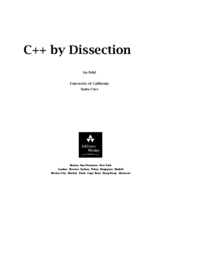Categoría "C++"
Se han encontrado 4 Coincidencias
C++ Plus Data Structures, 3rd Edition (2003)
C++ Plus Data Structures
149 Visitas | 276 Descargas | 2016-09-14 13:24:13 | pecarrazana
H istorically, has science broadened departments. a course considerably. on Over data the structures The lasttopic 18 years, has of been data however, structures a mainstay the focus has of now most of this been computer course sub- sumed under the broader topic of abstract data types (ADTs)—the study of classes of objects whose logical behavior is defined by a set of values and a set of operations. The term abstract data type describes a comprehensive collection of data values and operations; the term data structures refers to the study of data and how to repre- sent data objects within a program; that is, the implementation of structured rela- tionships. The shift in emphasis is representative of the move towards more abstraction in computer science education. We now are interested in the study of the abstract properties of classes of data objects in addition to how the objects might be represented in a program. Johannes J. Martin put it succinctly: “. . . depending on the point of view, a data object is characterized by its type (for the user) or by its structure (for the implementor).”1

C++ by Example: UnderC Learning
C++ by Example: UnderC Learning
135 Visitas | 236 Descargas | 2016-09-14 13:27:53 | pecarrazana
People learn best by example. It’s important to read as much good code as possi- ble, just as reading lots of English is the only way to learn to write it. This book presents nontrivial applications of C++ that are interesting, and the case stud- ies at the end of each chapter show C++ in use. I have provided the UnderC C++ interactive system for this edition. You should continuously play with the language, using UnderC, until you have enough confidence in the bricks to build your own houses. In addition, this book comes with the GNU Compiler Collection (GCC), which contains the most popular free C++ compiler.

Programación de Sistemas
Programación de Sistemas
149 Visitas | 165 Descargas | 2016-12-12 19:26:15 | stescobedo
En este texto repasaremos conceptos de multiprogramación como las definiciones de programa, proceso e hilos, y explicaremos el mecanismo de llamadas al sistema que emplea Linux para poder aceptar las peticiones desde el entorno de usuario. Seguidamente veremos las posibilidades que nos ofrece el Compilador de C de GNU, GCC, y programaremos nuestros primeros ejecutables para GNU/Linux. Después de repasar las llamadas al sistema más comunes, analizaremos las particularidades de UNIX a la hora de manejar directorios, permisos, etc., y nos adentraremos en la Comunicación Interproceso (IPC). Finalmente abordaremos de forma introductoria la programación de sockets de red, para dotar de capacidades telemáticas a nuestros programas.

C++ by Dissection
Programación
52 Visitas | 27 Descargas | 2021-04-04 14:19:28 | dhera
C++ by Dissection presents a thorough introduction to the programming process by carefully developing working programs to illuminate key features of the C++ program?ming language. Program code is explained in an easy-to-follow, careful manner through?out. The code has been tested on several platforms and is found on the bundled CD?rom accompanying this text. The code in C++ By Dissection can be used with most C++ systems, including those found in operating systems such as MacOS, MS-DOS, OS/2, UNIX, and Windows.
Contribuir
Usted puede contribuir con Libros UCLV, es importante para nosotros su aporte..
Contribuir